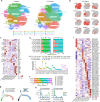A pan-cancer blueprint of the heterogeneous tumor microenvironment revealed by single-cell profiling
- PMID: 32561858
- PMCID: PMC7608385
- DOI: 10.1038/s41422-020-0355-0
A pan-cancer blueprint of the heterogeneous tumor microenvironment revealed by single-cell profiling
Abstract
The stromal compartment of the tumor microenvironment consists of a heterogeneous set of tissue-resident and tumor-infiltrating cells, which are profoundly moulded by cancer cells. An outstanding question is to what extent this heterogeneity is similar between cancers affecting different organs. Here, we profile 233,591 single cells from patients with lung, colorectal, ovary and breast cancer (n = 36) and construct a pan-cancer blueprint of stromal cell heterogeneity using different single-cell RNA and protein-based technologies. We identify 68 stromal cell populations, of which 46 are shared between cancer types and 22 are unique. We also characterise each population phenotypically by highlighting its marker genes, transcription factors, metabolic activities and tissue-specific expression differences. Resident cell types are characterised by substantial tissue specificity, while tumor-infiltrating cell types are largely shared across cancer types. Finally, by applying the blueprint to melanoma tumors treated with checkpoint immunotherapy and identifying a naïve CD4+ T-cell phenotype predictive of response to checkpoint immunotherapy, we illustrate how it can serve as a guide to interpret scRNA-seq data. In conclusion, by providing a comprehensive blueprint through an interactive web server, we generate the first panoramic view on the shared complexity of stromal cells in different cancers.
Conflict of interest statement
The authors declare no competing interests.
Figures









References
-
- Lambrechts D, et al. Phenotype molding of stromal cells in the lung tumor microenvironment. Nat. Med. 2018;24:1277–1289. - PubMed
Publication types
MeSH terms
LinkOut - more resources
Full Text Sources
Other Literature Sources
Medical
Research Materials

